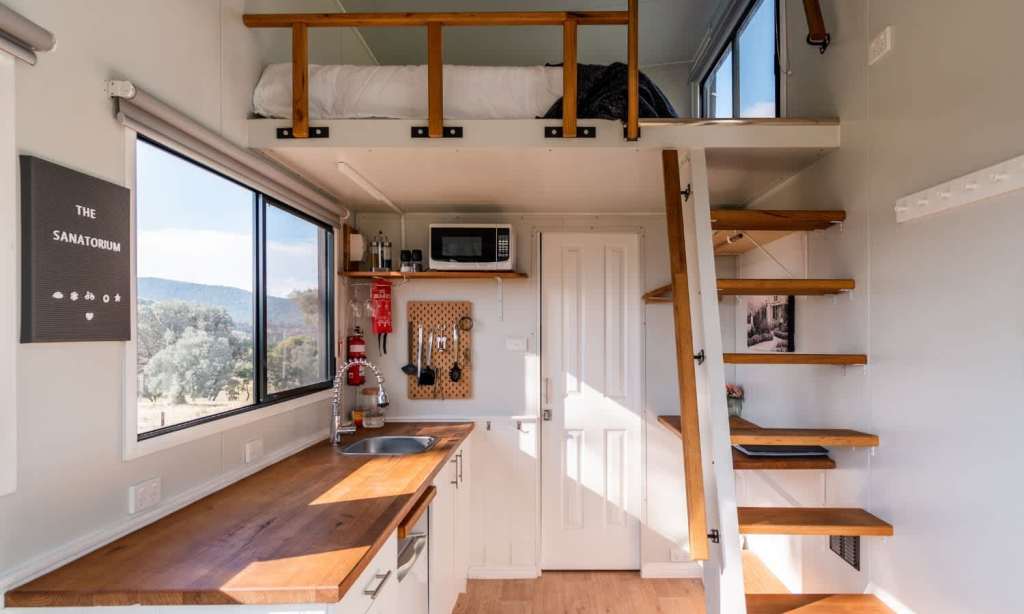Tiny home stays offer travellers quick and quirky breaks from their daily grinds. They’re cosy, yet often luxurious (some come with expansive decks and hot tubs) retreats in rural spots, including many that are hard to access otherwise.
But as property and rental prices in cities head upward, many of us are also squeezing our home lives into similarly small spaces. Data by the Australian Bureau of Statistics shows the national average floor area of new apartments shrunk by a massive 17.5% between 2003 and 2018 — and that trend isn’t likely to slow down any time soon.
Thankfully, there’s a lot you can do design-wise when it comes to tiny home living. We talked to Jeff Yeo, co-founder of tiny home accommodation provider Tiny Away, to get his expert tips on how to get the most out of your small space without compromising on convenience, comfort or style.
Remember Height Is Your Best Friend
When it comes to interior layout, we naturally limit our thinking to what we can put on the floor, but we’re ignoring the ample open space that’s gathered above our head, says Yeo.
“For example, in a small bedroom, you might consider building in elevated caverns — as we do in some of our tiny homes — which can create cosy spaces for sleeping or lounging. Meanwhile, you’ve still got all the same floor space you started with to use for other things you might otherwise struggle to fit in like storage, seating, or a workspace.
“If you don’t feel like climbing a ladder to sleep or relax, you might choose to use these elevated spaces for concealed storage cupboards instead.”
Use Light Colours to Maximise Feeling of Spaciousness
“Nothing will make a space feel smaller than it really is more than dark, oppressive colours — and it’s the science that says so. The problem with splashing too many dark colours around a room, whether it’s on the walls, floors or furniture, is that they absorb the natural light, whereas brighter tones will bounce the light around the room for an airier and more open feel.

“As a rule, you should always maximise the use of light colours and tones to achieve the most spacious feeling in a small area.”
Consider Opportunities to Create Multifunction Features
“You can’t afford to waste space when it’s in short supply, but a lot of standard fixtures, fittings and furniture will do exactly that — at least without a little re-imagination and fine-tuning. Stairs, coffee tables, side tables and beds, for example, often create dead zones underneath which have no practical use.
“Filling the void under stairs with bespoke storage cupboards is a key design feature of some of our tiny homes which have stairs leading to elevated sleeping caverns. Where possible, we’ll also include shelving, drawers or concealed cupboards beneath other functional features such as freestanding tables, work surfaces and desks.”
Make Furnishings Mobile
“One of the challenges of ensuring maximum amenity in a tiny home, which extends to living in a smaller space more generally, is working out how people can live comfortably and conveniently around all the necessary functional areas and furniture.
“Giving some of your furnishings mobility, such as adding wheels, will allow you to easily shift things around as you navigate your space for different uses or times of the day. Whether it’s a mobile extension of your kitchen worksurface or a manoeuvrable entertainment unit, coffee table, or couch, you might be surprised at how much easier life can be when the things around you aren’t stubbornly rooted to their spot.”
Be Bold with Statement Artworks
“Don’t make the common mistake of thinking that small cosy space equals perfect place for lots of trinkets. Filling a tiny area with too many decorative or personal possessions can quickly create a cluttered or overbearing feel when size is not on your side.
“On the other hand, a single large artwork or wall feature will become a real focal point – also giving the impression that your room is of a much bigger scale than it really is. I say feel free to go bold, from floor to ceiling or wall to wall, but leave it at that and enjoy your effort — or splurge.”
Use Wall Plants and Storage
“Surface areas and floor space might be in short supply, but natural greenery is always a must in any room. It’s often said that having plants in a living space is good for mental health and wellbeing because they make us feel more positive and relaxed in the environment.

“Securing plants to walls or using hanging pots from the ceiling is a great way to achieve your greenery goals without losing practical space. Creeper plants which can be attached to wall fittings are ideal because you usually get more greenery with less soil and pot.”
Build in a Charging Station for Devices
“Whether it’s in a drawer or cupboard, a dedicated charging station which can handle multiple devices like phones, laptops, and tablets should definitely be built in.
“Your charging station will help you avoid the temptation to leave valuable electronics in unsafe spots such as around wet areas or on the floor, or where they will get in the way of surface space like a kitchen bench — a common problem in small living spaces.”
Read more stories from The Latch and subscribe to our email newsletter.







